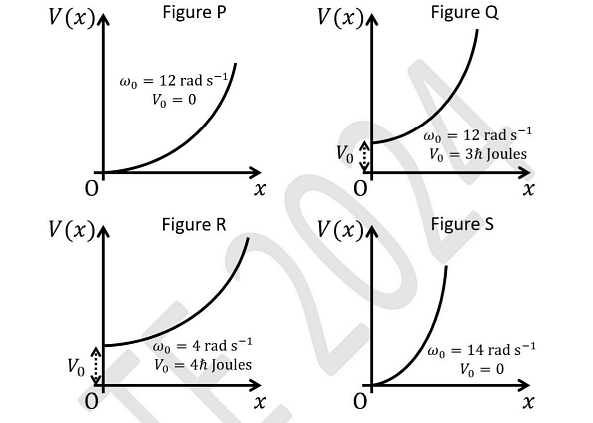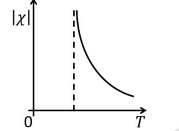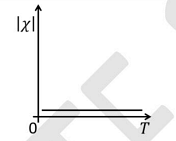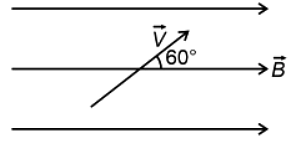Out of soft iron and steel which has more coercivity, less retentivity.
- iron
- steel
- both are equal
- can't say
The Correct Option is B
Solution and Explanation
Coercivity is the intensity of the applied magnetic field needed to reduce the magnetization of a material to zero. It represents the ability of a ferromagnetic material to resist becoming demagnetized in the presence of an external magnetic field.
Retentivity:
Retentivity is the ability of a material to retain magnetism after the magnetizing force is removed. It refers to the property of a magnetic material to maintain a certain level of magnetism even when the external magnetizing field is reduced to zero.
Since steel requires a stronger magnetic field to reduce its magnetization to zero, it has higher coercivity and lower retentivity compared to soft iron.
So, the correct option is B: Steel.
Top Questions on Magnetism and matter
- A particle of mass m is moving in the potential
\[ V(x) = \begin{cases} V_0 + \frac{1}{2} m \omega_{0P}^2 x^2 & \quad \text{if } x > 0 \\\infty & \quad \text{if } x \leq 0 \end{cases}\]
Figures P, Q, R, and S show different combinations of the values of \( \omega_0 \) and \( V_0 \).
Let \( E^{(P)}_j \), \( E^{(Q)}_j \), \( E^{(R)}_j \), and \( E^{(S)}_j \) with \( j = 0, 1, 2, \ldots \), be the eigen-energies of the j-th level for the potentials shown in Figures P, Q, R, and S, respectively. Which of the following statements is/are true?- GATE PH - 2024
- Physics
- Magnetism and matter
- A material behaves as a superconductor below a critical temperature \( T_c \) and as a normal conductor above \( T_c \). A magnetic field \(\overrightarrow{B} = B\hat{z}\) is applied when \( T > T_c \). The material is then cooled below \( T_c \) in the presence of \( \vec{B} \). Which of the following figures represents the correct configuration of magnetic field lines?
- GATE PH - 2024
- Physics
- Magnetism and matter
- The temperature \( T \) dependence of magnetic susceptibility \( \chi \) (Column I) of certain magnetic materials (Column II) are given below. Which of the following options is/are correct?
Column I Column II (1) 
(P) Diamagnetic (2) 
(Q) Paramagnetic (3) 
(R) Ferromagnetic (4) 
(S) Antiferromagnetic - GATE PH - 2024
- Physics
- Magnetism and matter
- An infinite one-dimensional lattice extends along the x-axis. At each lattice site, there exists an ion with spin 1/2. The spin can point either in the +z or -z direction only. Let \( S_P \), \( S_F \), and \( S_A \) denote the entropies of paramagnetic, ferromagnetic, and antiferromagnetic configurations, respectively. Which of the following relations is/are true?
- GATE PH - 2024
- Physics
- Magnetism and matter
A proton is projected with speed v in magnetic field B of magnitude 1 T. The angle between velocity and magnetic field is 600 as shown below. The kinetic energy of a proton is 2 eV (mass of proton = \(1.67\times10^{-27} kg\), e = \(1.6\times10^{-19}\)C). The pitch of the path of the proton is approximately?

- JEE Main - 2023
- Physics
- Magnetism and matter
Questions Asked in JIPMER exam
- Binomial nomenclature was first introduced by
- JIPMER - 2015
- KCET - 2022
- Diversity In The Living World
- A convex lens $'A'$ of focal length $20\, cm$ and a concave lens $'B'$ of focal length $5\, cm$ are kept along the same axis with a distance $'d'$ between them. If a parallel beam of light falling on $'A'$ leaves $'B'$ as a parallel beam, then the distance $'d'$ in cm will be :
- JIPMER - 2021
- Spherical Mirrors
- A bacterial flagellum is composed of
- JIPMER - 2021
- Prokaryotic Cells
- $2,4-DNP $ test can be used to identify :
- JIPMER - 2021
- Chemical Reactions
- How many moles of acidified $K_2Cr_2O_7$ is required to liberate $6$ moles of $I_2$ from an aqueous solution of $I^-$ ?
- JIPMER - 2020
- Mole concept and Molar Masses
Concepts Used:
Magnetism & Matter
Magnets are used in many devices like electric bells, telephones, radio, loudspeakers, motors, fans, screwdrivers, lifting heavy iron loads, super-fast trains, especially in foreign countries, refrigerators, etc.
Magnetite is the world’s first magnet. This is also called a natural magnet. Though magnets occur naturally, we can also impart magnetic properties to a substance. It would be an artificial magnet in that case.
Read More: Magnetism and Matter
Some of the properties of the magnetic field lines are:
- The lines and continuous and outside the magnet, the field lines originate from the North pole and terminate at the South pole
- They form closed loops traversing inside the magnet.
- But here the lines seem to originate from the South pole and terminate at the North pole to form closed loops.
- More number of close lines indicate a stronger magnetic field
- The lines do not intersect each other
- The tangent drawn at the field line gives the direction of the field at that point.



